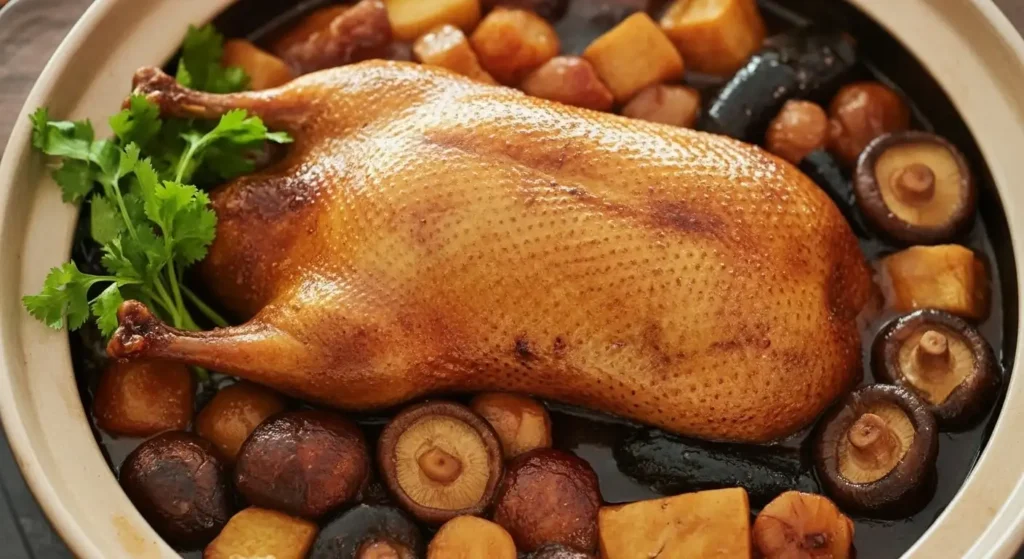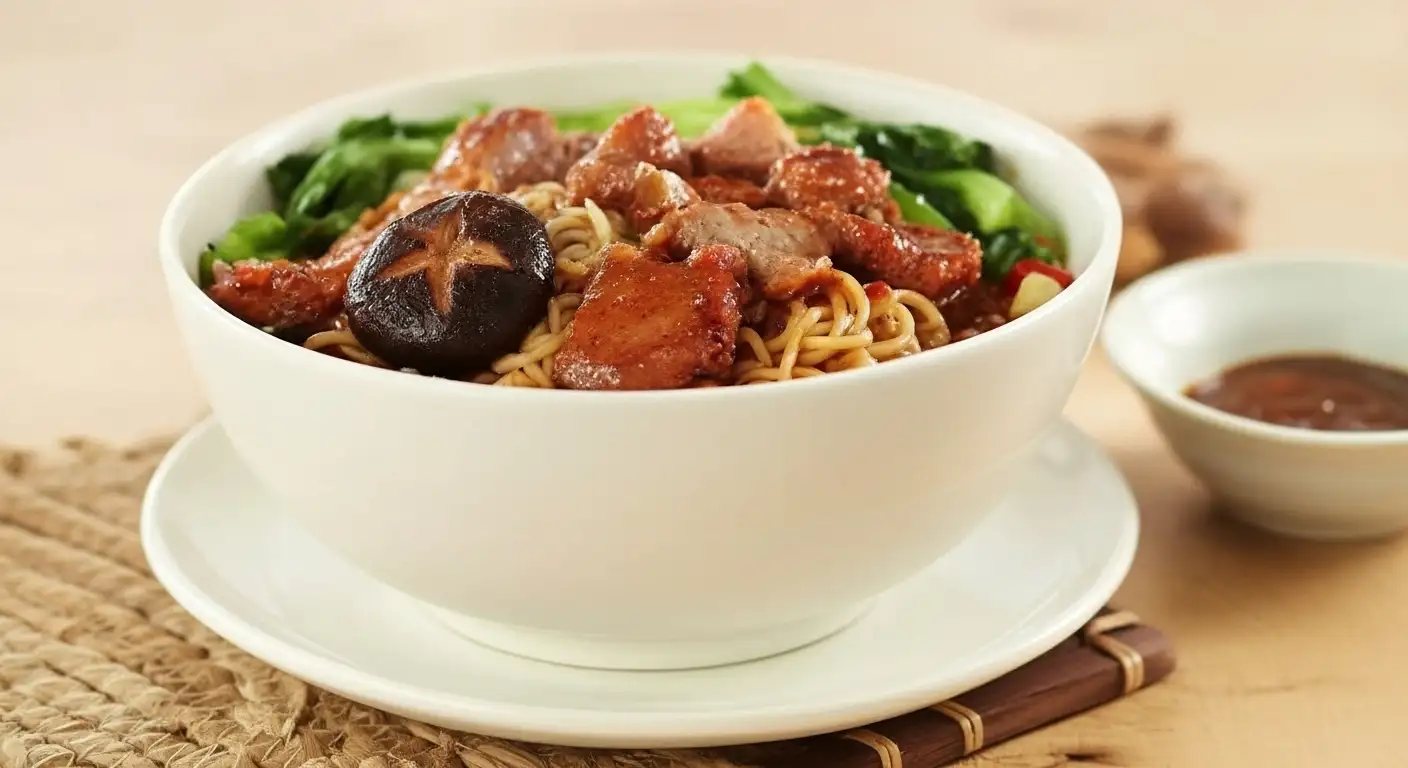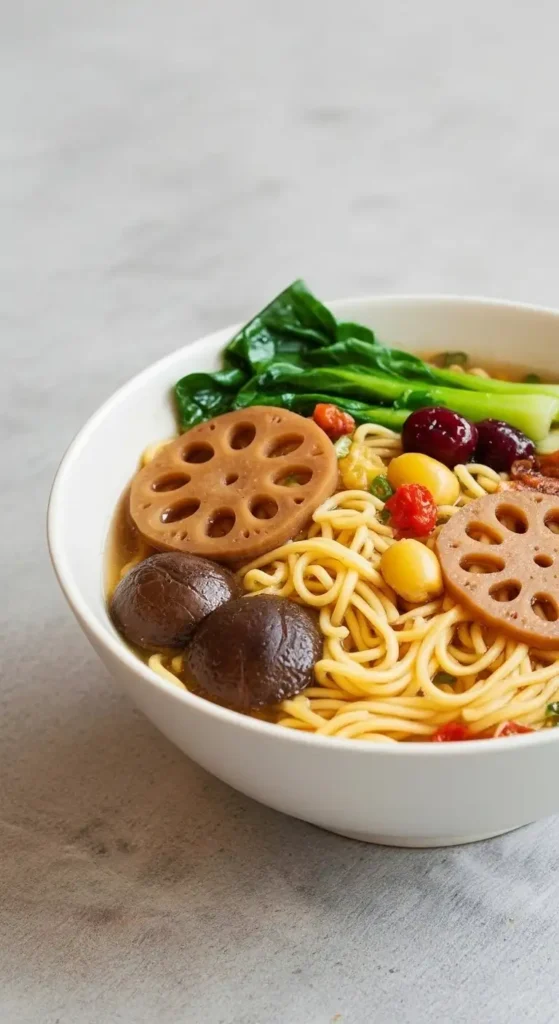Mì Vịt Tiềm (pronounced mee vit teem) is not just a dish; it’s a rich, nourishing culinary experience that bridges Vietnamese and Chinese culinary traditions. Originating from the Chinese communities in Southern Vietnam, particularly Ho Chi Minh City (Saigon), this noodle soup is celebrated for its deeply aromatic herbal broth and tender, slow-cooked duck.
The Basics of Mì Vịt Tiềm
What is it?
Mì means “yellow egg noodles,” Vịt means “duck,” and Tiềm means “to braise or stew in an herbal broth.”
It is essentially a Braised Duck Egg Noodle Soup where a whole duck leg is slow-cooked until fall-off-the-bone tender in a dark, medicinal broth.
Origin and Significance:
Mì Vịt Tiềm is a quintessential dish of the Vietnamese-Chinese (Hoa) community, making it most prominent in the bustling Chinese neighborhoods of Ho Chi Minh City (District 5 and 6).
The use of Chinese medicinal herbs means it is often considered a restorative and nourishing meal, especially popular during cooler weather or when one is seeking a health boost.
The Broth:
The broth is the heart of the dish. It has a rich, dark hue (often achieved with dark soy sauce) and a deeply savory flavor infused with a complex blend of Chinese herbs and spices, known as thuốc Bắc (traditional Northern medicine ingredients).
Key aromatics include star anise, cinnamon, dried shiitake mushrooms, dried jujubes (red dates – táo tàu), and goji berries (kỷ tử).

The Components and Variations of Mì Vịt Tiềm
Mì Vịt Tiềm is generally a fixed, specialized dish, but the main “types” depend on the preparation of the duck and the choice of noodles.
| Component Category | Vietnamese Name | Description |
|---|---|---|
| The Star Protein | Vịt Tiềm (Braised Duck Leg) | The duck leg is typically seasoned, pan-fried or deep-fried briefly for a crispy skin, and then slow-braised in the herbal broth for hours until it is incredibly tender and fully infused with the medicinal flavors. |
| The Noodles | Mì Trứng (Egg Noodles) | Traditionally, a thin, chewy Chinese-style yellow egg noodle is used. These noodles retain a satisfying bounce even when soaked in the soup. |
| The Herbs | Thuốc Bắc (Herbal Ingredients) | The core flavor comes from a blend of medicinal herbs like thục địa (processed Rehmannia root, which imparts color and sweetness), jujubes, goji berries, and warming spices like star anise and cassia bark. |
| Common Toppings | Nấm Đông Cô, Cải Thìa | Dried shiitake mushrooms (braised in the soup) and blanched green vegetables, such as bok choy or cải thìa, add freshness and texture. |
| Common Variation | Mì Vịt Tiềm Chay (Vegetarian) | A vegetarian version often substitutes the duck with "mock duck" made from fried wheat gluten and utilizes a vegetable-based herbal broth, popular among Buddhist practitioners. |
How to Enjoy Mì Vịt Tiềm
Mì Vịt Tiềm is eaten much like any other noodle soup, but with a focus on savoring the depth of the broth and the tenderness of the duck.
Chopstick and Spoon: The noodles are served in the bowl, topped with the whole braised duck leg and a generous ladle of the hot, dark herbal broth, along with shiitake mushrooms and blanched greens.
Savor the Duck: Use chopsticks to gently pull the meat off the bone—it should be so tender that it falls away easily. For an enhanced experience, many restaurants serve the duck with a side of dark, savory dipping sauce (often a mixture of the braising liquid, dark soy sauce, and a hint of vinegar). Dip the duck meat into this sauce before eating.
Balance the Flavor: The broth is already complex, but diners may add a dash of chili sauce or fresh chili slices for heat, or a little extra soy sauce for saltiness, though it is usually perfectly seasoned upon arrival.
A Sip of Wellness: Be sure to drink the broth slowly. The warming, aromatic quality of the herbs is meant to be enjoyed for its nourishing and restorative qualities.

Regional Differences in Mì Vịt Tiềm
Mì Vịt Tiềm is overwhelmingly a Southern Vietnamese specialty due to its deep connection to the Hoa (Chinese-Vietnamese) diaspora, whose population is highly concentrated in Ho Chi Minh City.
| Region | Status and Characteristics | Key Differences |
|---|---|---|
| Southern Vietnam (Ho Chi Minh City) | The True Home. This is where the dish thrives, often found in specialized Mì or Chinese noodle shops with decades of history. It is considered an authentic, classic dish. | Broth is dark, rich, and intensely herbal, featuring the full array of Chinese medicinal herbs and a pronounced sweetness from the long braising process (often using rock sugar and thục địa). The duck is the focal point, served tender and deeply flavored. |
| Northern & Central Vietnam | Less Common/Adapted. While you can find variations of braised duck or duck noodle soup, the specific Mì Vịt Tiềm preparation—with the heavy use of Chinese medicinal herbs and the dark, tiềm-style broth—is rare outside of major cities, and often represents a Southern adaptation if found. | Local duck noodle soups (Bún Măng Vịt in the North) are generally lighter and simpler, featuring local Vietnamese herbs and clear broths, rather than the dark, intensely medicinal, and sweet flavor profile of Mì Vịt Tiềm. |
| Overall | The defining elements of Mì Vịt Tiềm (the dark color, sweetness, and specific herbal blend) are trademarks of Southern Chinese influence and are not native to Northern or Central Vietnamese cuisine. |




